A Novel High-Speed Split-Gate Trench Carrier-Stored Trench-Gate Bipolar Transistor with Enhanced Short-Circuit Roughness
Abstract
:1. Introduction
2. Structure and Process Flow
3. Simulation Results and Discussion
4. Conclusions
Author Contributions
Funding
Data Availability Statement
Conflicts of Interest
References
- Takahashi, H.; Haruguchi, H.; Hagino, H.; Yamada, T. Carrier stored trench-gate bipolar transistor (CSTBT)-a novel power device for high voltage application. In Proceedings of the 8th International Symposium on Power Semiconductor Devices and Ics, ISPSD’96, Proceedings, Maui, HI, USA, 23 May 1996; pp. 349–352. [Google Scholar]
- Takahashi, T.; Tomomatsu, Y.; Sato, K. CSTBT (III) as the next generation IGBT. In Proceedings of the 20th International Symposium on Power Semiconductor Devices and IC’s, Orlando, FL, USA, 18–22 May 2008; pp. 72–75. [Google Scholar]
- Honda, S.; Haraguchi, Y.; Narazaki, A.; Terashima, T.; Terasaki, Y. Next generation 600V CSTBT™ with an advanced fine pattern and a thin wafer process technologies. In Proceedings of the 24th International Symposium on Power Semiconductor Devices and ICs, Bruges, Belgium, 3–7 June 2012; pp. 149–152. [Google Scholar]
- Zhang, J.; Xiao, X.; Zhu, R.; Zhao, Q.; Zhang, B. Low loss and low EMI noise CSTBT with split gate and recessed emitter trench. IEEE J. Electron Devices Soc. 2021, 9, 704–712. [Google Scholar] [CrossRef]
- Nakamura, K.; Sadamatsu, K.; Oya, D.; Shigeoka, H.; Hatade, K. Wide Cell Pitch LPT (II)-CSTBT™(III) technology rating up to 6500 V for low loss. In Proceedings of the 22nd International Symposium on Power Semiconductor Devices & IC’s (ISPSD), Hiroshima, Japan, 6–10 June 2010; pp. 387–390. [Google Scholar]
- Xu, X.; Chen, W.; Liu, C.; Wang, Y.; Chen, N.; Wang, F.; Shi, Q.; Zhang, K.; Zhou, Q.; Li, Z.; et al. A Novel CSTBT with Hole Barrier for High dV/dt Controllability and Low EMI Noise. In Proceedings of the 31st International Symposium on Power Semiconductor Devices and ICs (ISPSD), Shanghai, China, 19–23 May 2019; pp. 331–334. [Google Scholar] [CrossRef]
- Li, P.; Kong, M.; Chen, X. A novel diode-clamped CSTBT with ultra-low on-state voltage and saturation current. In Proceedings of the 28th International Symposium on Power Semiconductor Devices and ICs (ISPSD), Prague, Czech Republic, 12–16 June 2016; pp. 307–310. [Google Scholar]
- Kamibaba, R.; Konishi, K.; Fukada, Y.; Narazaki, A.; Tarutani, M. Next generation 650V CSTBT TM with improved SOA fabricated by an advanced thin wafer technology. In Proceedings of the 2015 IEEE 27th International Symposium on Power Semiconductor Devices & IC’s (ISPSD), Hong Kong, China, 10–14 May 2015; pp. 29–32. [Google Scholar]
- Iwamuro, N.; Laska, T. IGBT history, state-of-the-art, and future prospects. IEEE Trans. Electron Devices 2017, 64, 741–752. [Google Scholar] [CrossRef]
- Zhang, J.; Wang, K.; Luo, J.; Zhao, Y.; Li, Z.; Ren, M.; Gao, W.; Zhang, B. Numerical analysis of impact of shield gate on trench IGBT and CSTBT. In Proceedings of the 2019 IEEE International Conference on Electron Devices and Solid-State Circuits (EDSSC), Xi’an, China, 12–14 June 2019; pp. 1–3. [Google Scholar]
- Xu, H.; Feng, T.; Guo, J.; Cui, W.; Yang, Y.; Sun, Q.Q.; Zhang, D.W. A Low Conduction Loss IGBT with Hole Path and Temperature Sensing. IEEE Trans. Electron Devices 2023, 70, 5236–5241. [Google Scholar] [CrossRef]
- Xu, H.; Yang, Y.; Tan, J.; Zhu, H.; Sun, Q.-Q.; Zhang, D.W. Carrier Stored Trench-Gate Bipolar Transistor with Stepped Split Trench-Gate Structure. IEEE Trans. Electron Devices 2022, 69, 5450–5455. [Google Scholar] [CrossRef]
- Laska, T.; Munzer, M.; Pfirsch, F.; Scaeffer, C.; Schmidt, T. The field stop IGBT (FS IGBT). A new power device concept with a great improvement potential. In Proceedings of the 12th International Symposium on Power Semiconductor Devices & ICs, Proceedings (Cat. No. 00CH37094), Toulouse, France, 22–25 May 2000; pp. 355–358. [Google Scholar] [CrossRef]
- Kitagawa, M.; Omura, I.; Hasegawa, S.; Inoue, T.; Nakagawa, A. A 4500 V injection enhanced insulated gate bipolar transistor (IEGT)operating in a mode similar to a thyristor. In Proceedings of the IEEE International Electron Devices Meeting, Washington, DC, USA, 5–8 December 1993; pp. 679–682. [Google Scholar] [CrossRef]
- Antoniou, M.; Lophitis, N.; Bauer, F.; Nistor, I.; Bellini, M.; Rahimo, M.; Amaratunga, G.; Udrea, F. Novel approach toward plasma enhancement in trench-insulated gate bipolar transistors. IEEE Electron. Device Lett. 2015, 36, 823–825. [Google Scholar] [CrossRef]
- Williams, R.K.; Darwish, M.N.; Blanchard, R.A.; Siemieniec, R.; Rutter, P.; Kawaguchi, Y. The Trench Power MOSFET: Part I—History, Technology, and Prospects. IEEE Trans. Electron Devices 2017, 64, 674–691. [Google Scholar] [CrossRef]
- Huang, J.; Huang, H.; Lyu, X.; Chen, X.B. Simulation Study of a Low Switching Loss FD-IGBT with High dI/dt and dV/dt Controllability. IEEE Trans. Electron Devices 2018, 65, 5545–5548. [Google Scholar] [CrossRef]
- Huang, J.; Huang, H.; Chen, X.B. Simulation Study of a Low ON-State Voltage Superjunction IGBT with Self-Biased PMOS. IEEE Trans. Electron Devices 2019, 66, 3242–3246. [Google Scholar] [CrossRef]
- Jiang, M.; Gao, L. Simulation Study of a Thyristor Conduction-Insulated Gate Bipolar Transistor (TC-IGBT) with a p-n-p Base and an n-p-n Collector for Reducing Turn-Off Loss. IEEE Trans. Electron Devices 2020, 67, 2854–2858. [Google Scholar] [CrossRef]
- Saito, W.; Nishizawa, S. Alternated Trench-Gate IGBT for Low Loss and Suppressing Negative Gate Capacitance. IEEE Trans. Electron Devices 2020, 67, 3285–3290. [Google Scholar] [CrossRef]
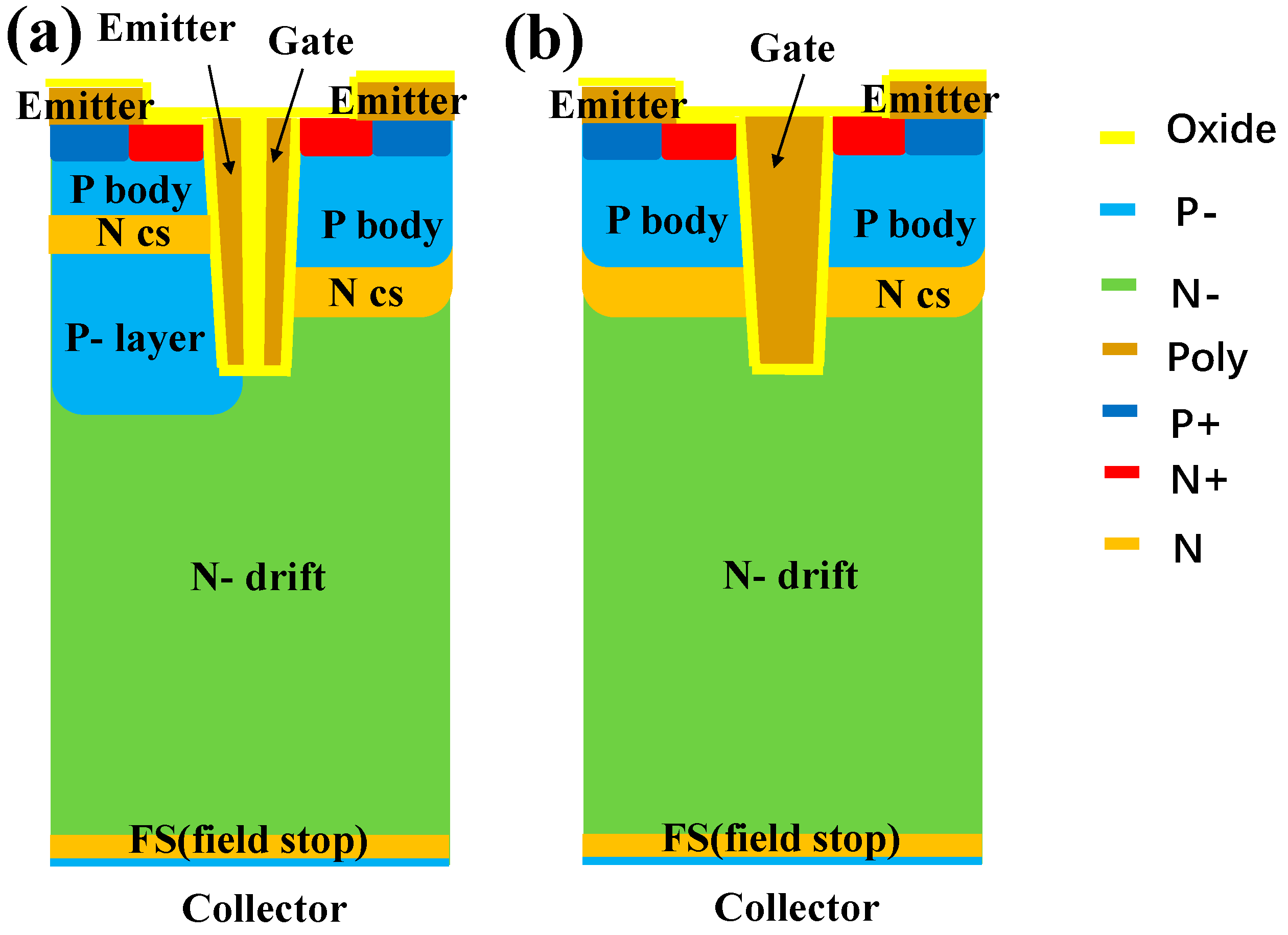

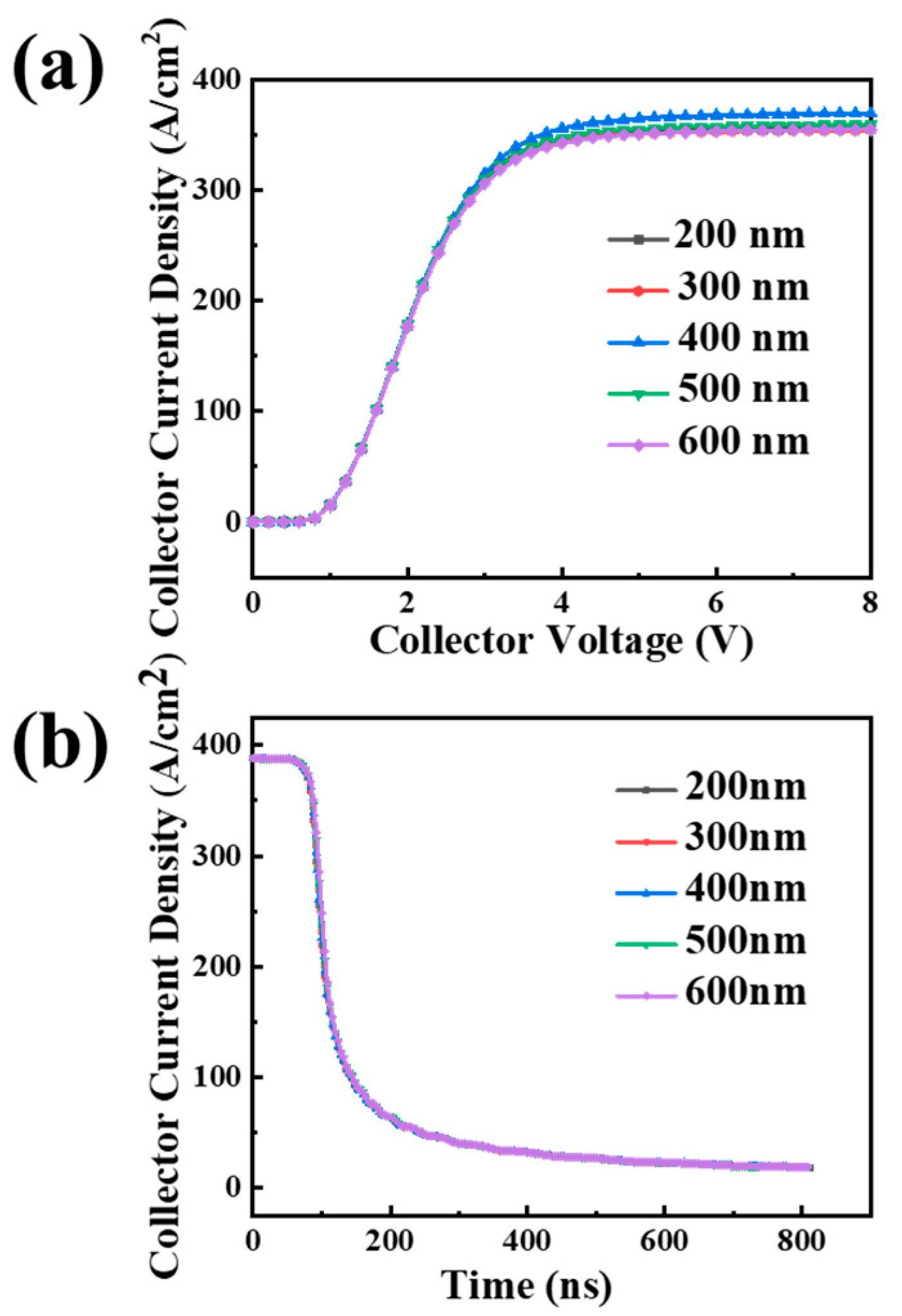

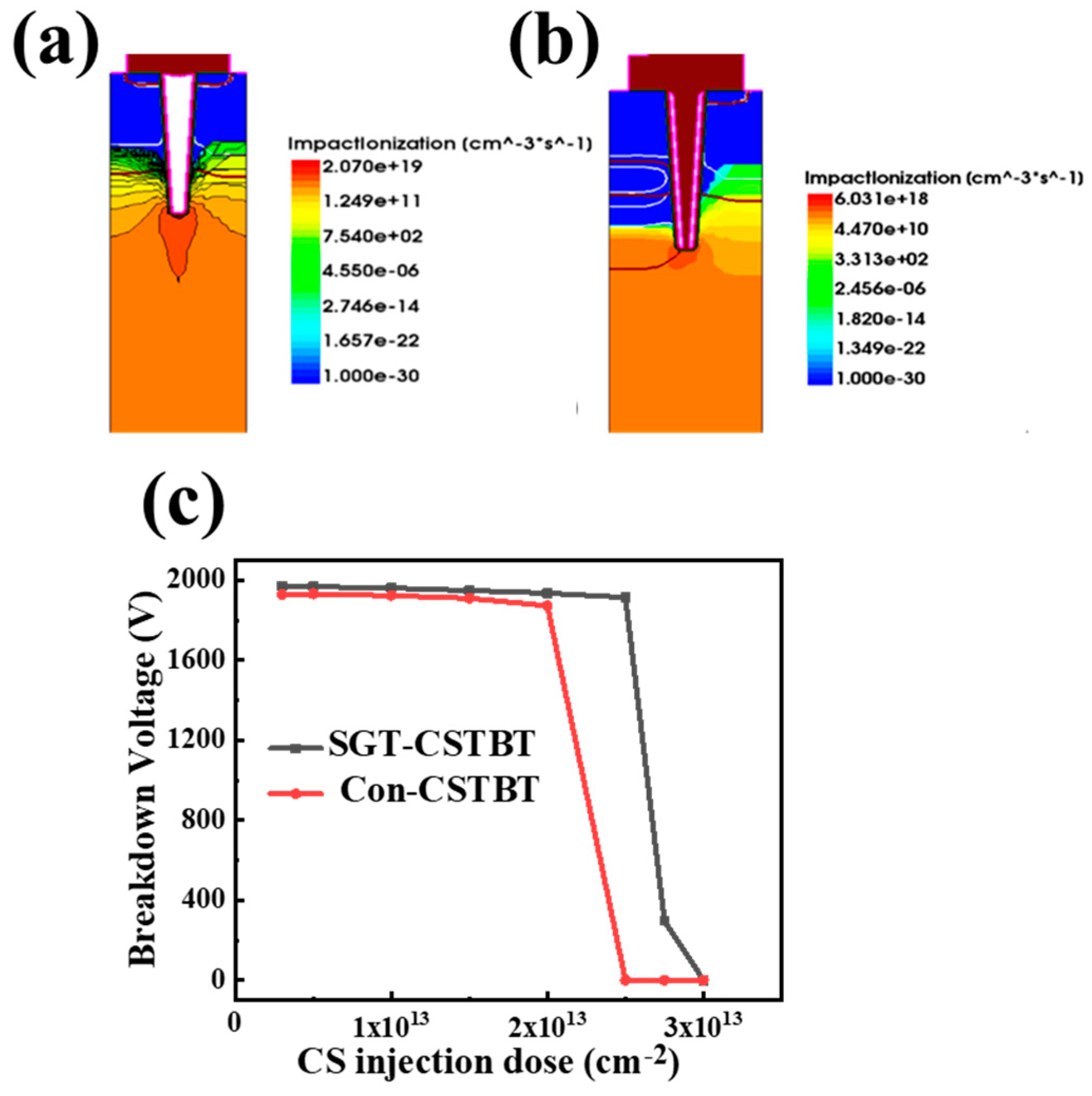

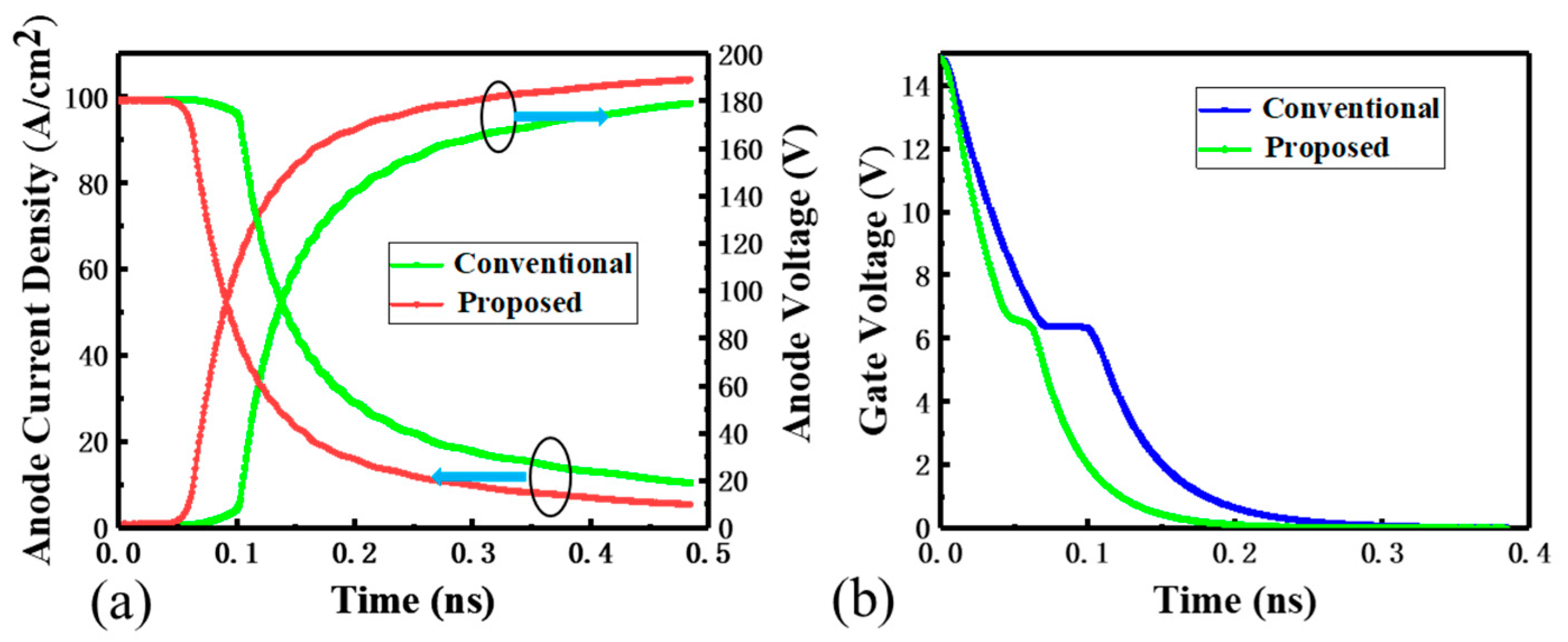

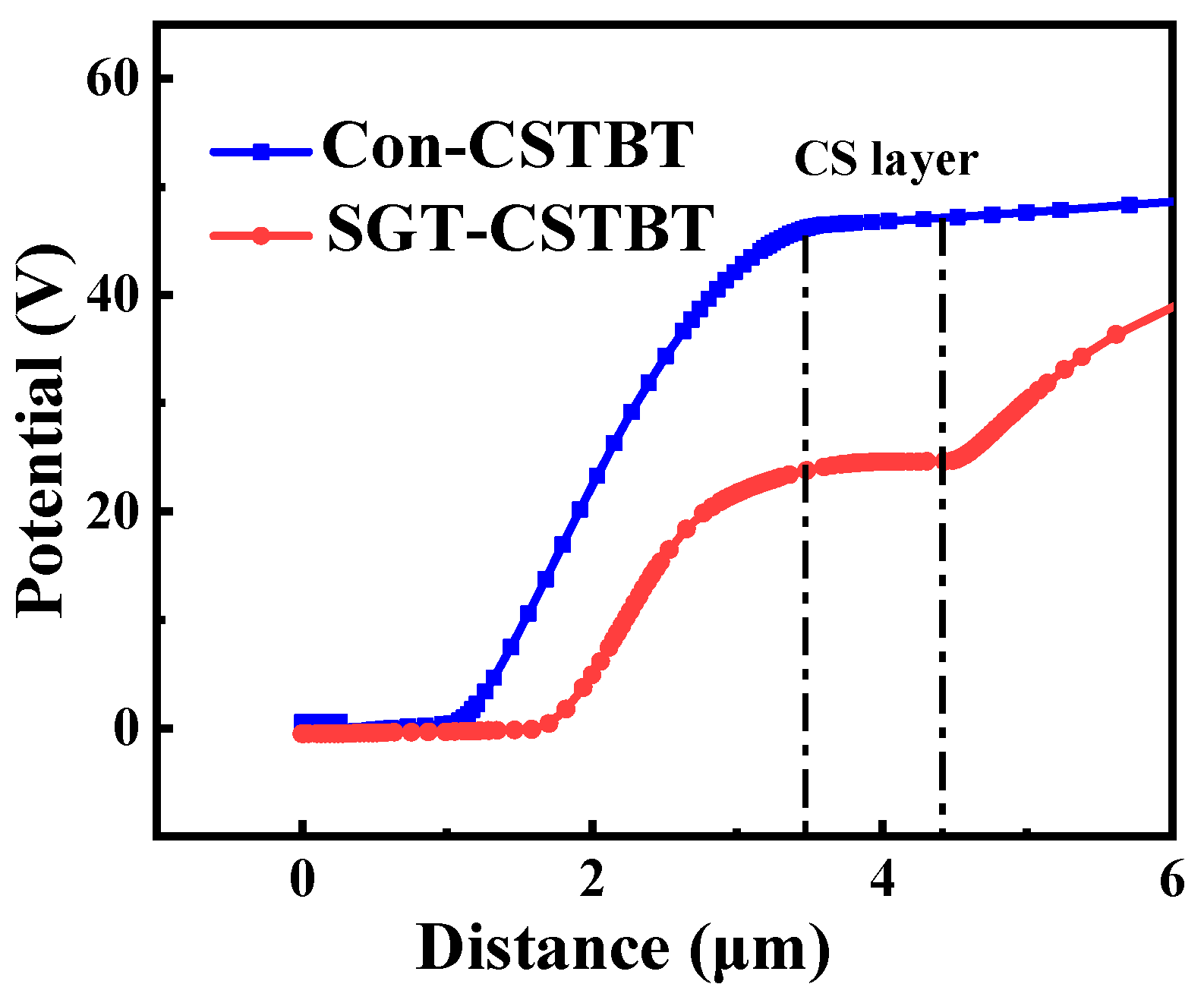
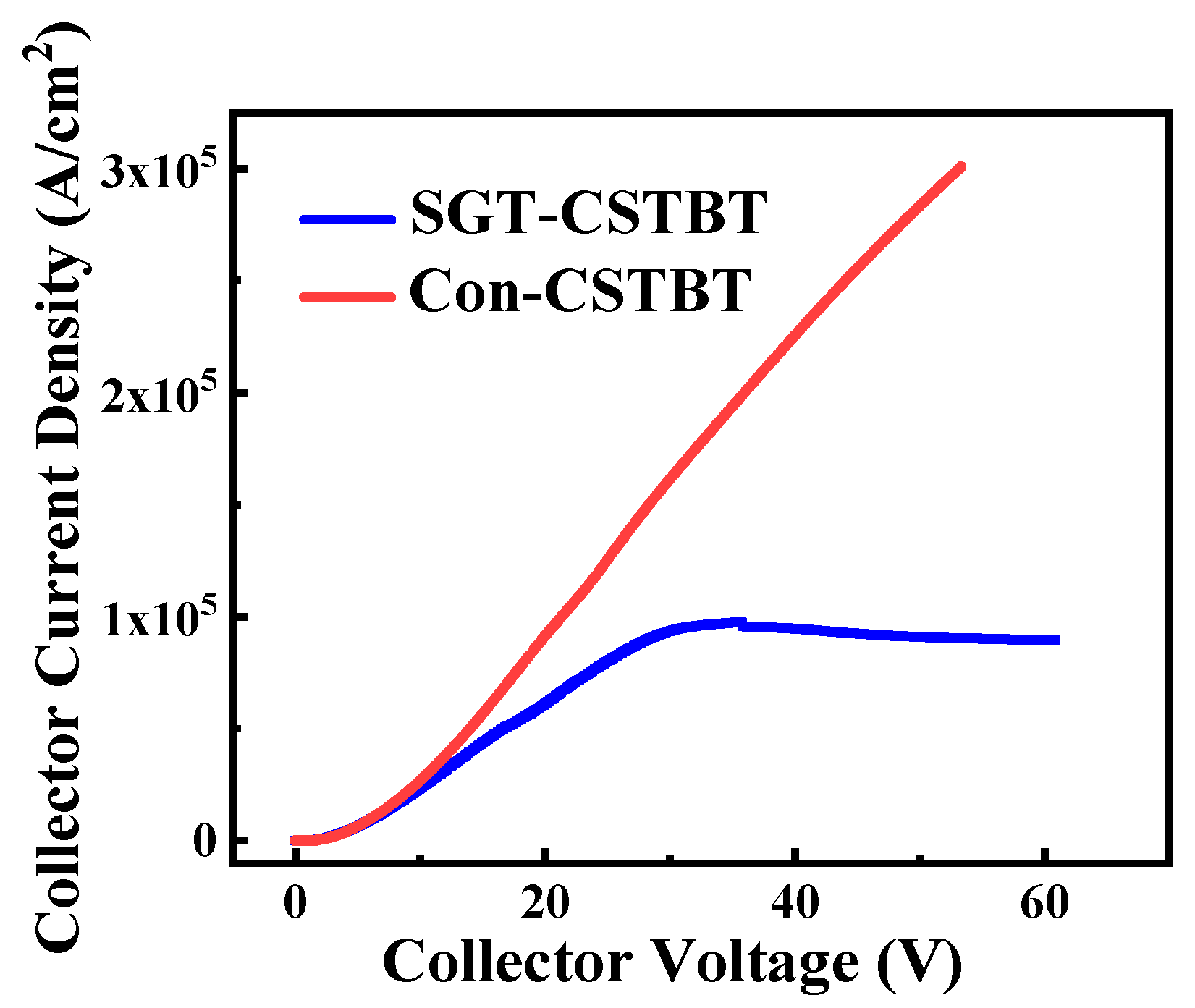
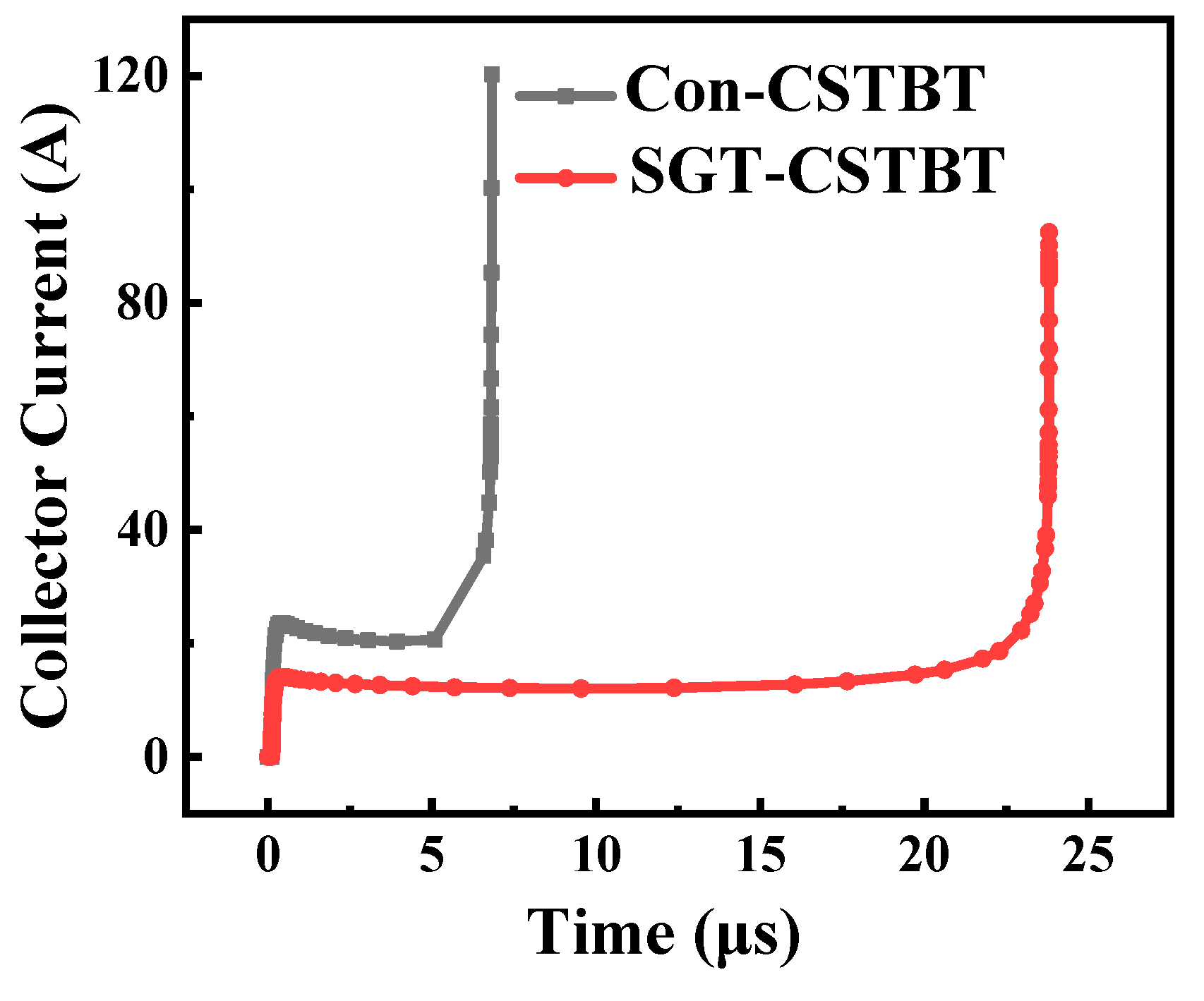
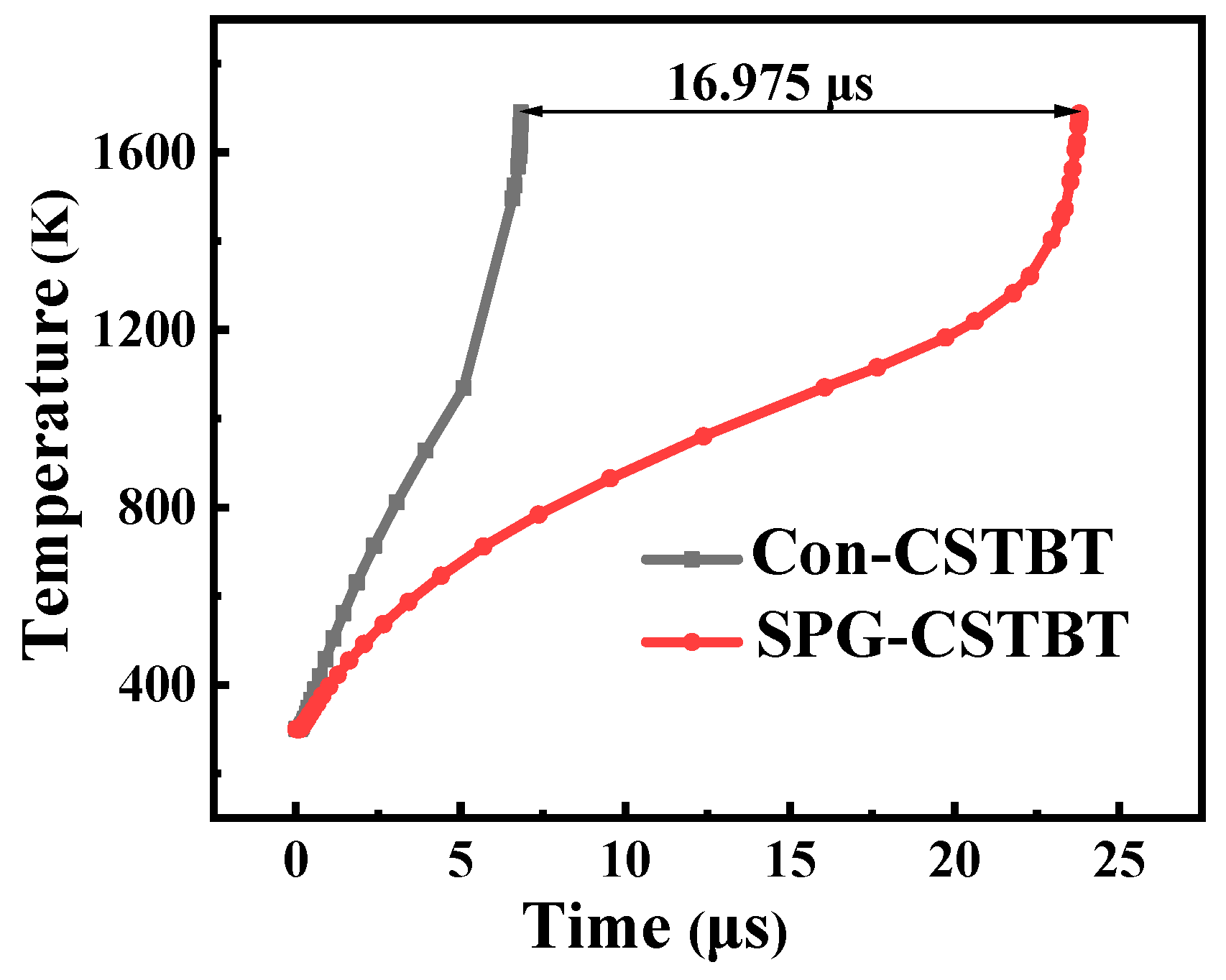
| Parameter | Value |
|---|---|
| Cell pitch | 4 μm |
| Gate oxide thickness | 120 nm |
| N-drift doping | 5.9 × 1013 cm−3 |
| CS left doping | 1.0 × 1018 cm−3 |
| CS right doping | 2.0 × 1017 cm−3 |
| P-well doping | 3.0 × 1016 cm−3 |
| Trench depth | 5 μm |
Disclaimer/Publisher’s Note: The statements, opinions and data contained in all publications are solely those of the individual author(s) and contributor(s) and not of MDPI and/or the editor(s). MDPI and/or the editor(s) disclaim responsibility for any injury to people or property resulting from any ideas, methods, instructions or products referred to in the content. |
© 2024 by the authors. Licensee MDPI, Basel, Switzerland. This article is an open access article distributed under the terms and conditions of the Creative Commons Attribution (CC BY) license (https://creativecommons.org/licenses/by/4.0/).
Share and Cite
Qian, Z.; Cui, W.; Feng, T.; Xu, H.; Yang, Y.; Sun, Q.; Zhang, D.W. A Novel High-Speed Split-Gate Trench Carrier-Stored Trench-Gate Bipolar Transistor with Enhanced Short-Circuit Roughness. Micromachines 2024, 15, 680. https://doi.org/10.3390/mi15060680
Qian Z, Cui W, Feng T, Xu H, Yang Y, Sun Q, Zhang DW. A Novel High-Speed Split-Gate Trench Carrier-Stored Trench-Gate Bipolar Transistor with Enhanced Short-Circuit Roughness. Micromachines. 2024; 15(6):680. https://doi.org/10.3390/mi15060680
Chicago/Turabian StyleQian, Zhehong, Wenrong Cui, Tianyang Feng, Hang Xu, Yafen Yang, Qingqing Sun, and David Wei Zhang. 2024. "A Novel High-Speed Split-Gate Trench Carrier-Stored Trench-Gate Bipolar Transistor with Enhanced Short-Circuit Roughness" Micromachines 15, no. 6: 680. https://doi.org/10.3390/mi15060680





